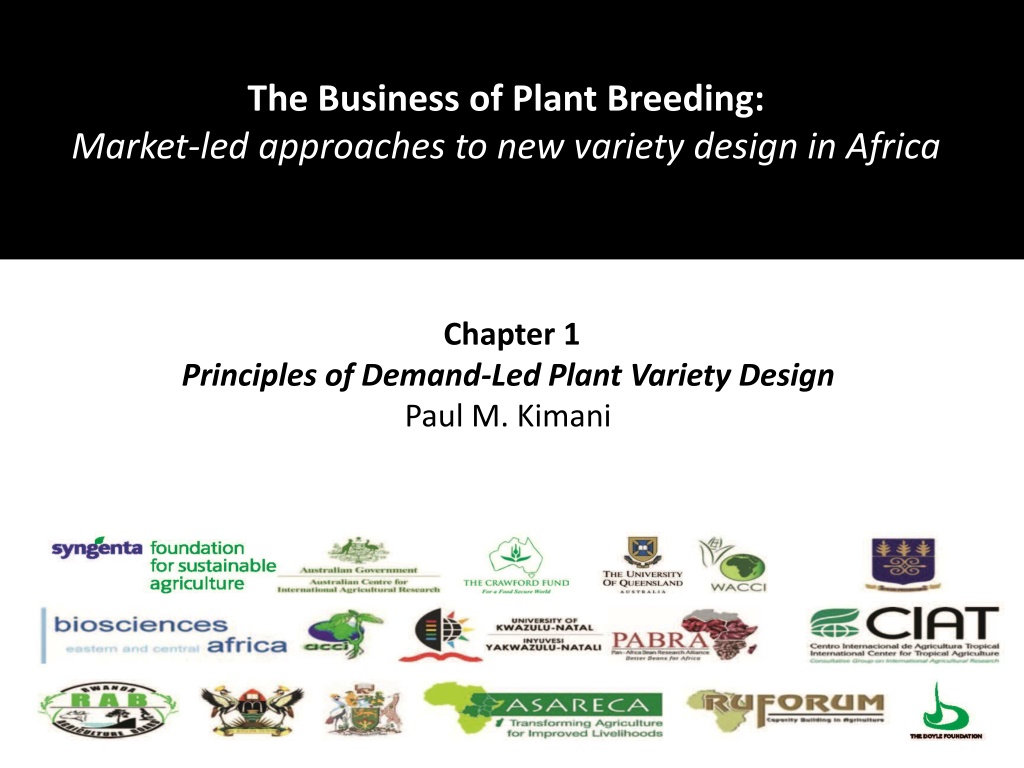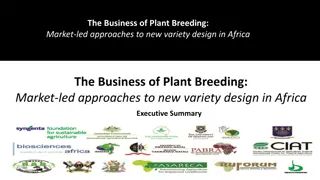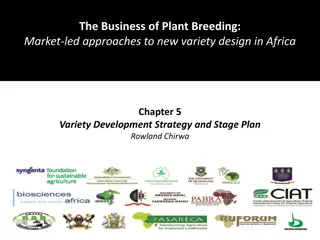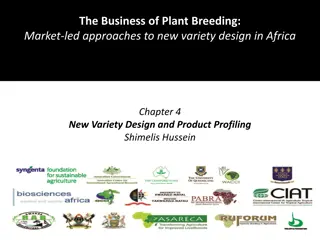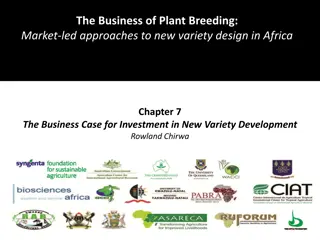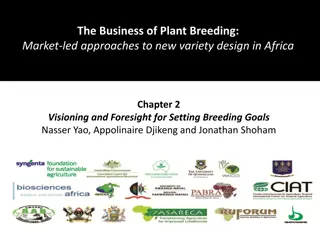Principles of Demand-Led Plant Variety Design in Africa
This manual delves into the principles of demand-led plant variety design, focusing on the challenges facing African agriculture, modern variety adoption rates, and breeding objectives. It provides insights on how breeder success in developing improved crop varieties can be measured, emphasizing the transformation of agriculture in Africa towards market-led approaches.
Download Presentation

Please find below an Image/Link to download the presentation.
The content on the website is provided AS IS for your information and personal use only. It may not be sold, licensed, or shared on other websites without obtaining consent from the author. Download presentation by click this link. If you encounter any issues during the download, it is possible that the publisher has removed the file from their server.
E N D
Presentation Transcript
Demand-Led Plant Breeding Training Manual The Business of Plant Breeding: Market-led approaches to new variety design in Africa Chapter 1 Principles of Demand-Led Plant Variety Design Paul M. Kimani
Chapter 1 Principles of Demand-Led Plant Variety Design Paul M. Kimani Plant Breeding and Biotechnology Program Department of Plant Science and Crop Protection, College of Agriculture and Veterinary Sciences University of Nairobi, P.O Box 29053-00625 Nairobi, KENYA pmkimani@uonbi.ac.ke 2
Chapter 1 Objectives 1. To understand the current status and challenges facing African agriculture 2. To review modern variety adoption in Africa 3. To understand the principles of demand-led breeding and similarities and differences with current practices 3
Chapter 1 Contents 1. Introduction Transformation of agriculture in Africa Variety adoption in Africa 2. Breeding Goals and Objectives 3. Principles of Demand-led Plant Variety Design 4. Conclusion 4
Opening Discussion What do you think is the adoption rate of modern varieties in Africa? Why is adoption low or high, by crop or country? Can you recognize your varieties in farmers fields? What do you want to achieve as a breeder? How do you measure your success in breeding improved crop varieties? 5
Adoption of Modern Varieties of Food Crops in Africa Crop Total area (ha) % MVs Country observations 14 11 1 3 9 17 19 5 2 8 10 9 8 18 5 3 2 1 5 1 1 152 Adopted area (ha) 1,041,923 6,556,762 850,121 182,452 6,470,405 4,376,237 2,582,317 211,772 317,597 1,409,309 1,854,543 723,544 4,927,345 3,117,621 2,552,121 1,185,306 9,972,479 1,453,820 365,901 14,695,862 11,035,995 6,787,043 615,737 970,720 4,673,300 6,356,963 2,497,209 17,965,926 11,471,533 14,089,940 249,632 614,606 94,946 1,478,086 915,877 230,749 107,721,630 89.7 65.7 62.5 49.9 44.0 39.7 38.0 34.4 32.7 30.2 29.2 29.0 27.4 27.2 18.1 15.0 14.0 10.4 6.9 6.2 1.5 34.78 Soybean Maize WCA Wheat Pigeonpea Maize ESA Cassava Rice Potatoes Barley Yams Groundnut Bean Sorghum Cowpeas Pearl millet Chickpea Faba bean Lentils Sweetpotato Banana Field peas Total/weighted average 37,438 85,806 9,874 102,143 56,784 3,461 37,469,577 DIIVA project (2014)
1. Introduction Transformation of Africa s agriculture Africa s agriculture is at a tipping point; moving from subsistence systems to more market-led systems Smallholder farmers are generating surpluses of products to sell in local, national, regional and international markets Demand for products is rising with population growth, urbanization and changing lifestyles Anew breed of consumers focused, choosy and ready to pay for quality and safety of food 7
Transformation of Africas agriculture Enabling small scale farmers to access the expanding markets is a critical challenge facing policy makers Participation of smallholders in markets requires : Identification of market demands Developing products with suitable characteristics to meet market requirements 8
Variety Adoption in Africa DIIVA study 2014 shows about 35% adoption of new varieties, of 20 crops in 30 African countries over previous 15 years Compares with average of 60% new variety adoption in Asia and 80% in Latin America 9
Variety Adoption in Africa Constraints and issues in low adoption Awareness Availability Profitability Measuring adoption levels Pros and cons of various methods Quality of data is the key requirement Expert opinion, focus groups and survey data 10
2. Breeding Goals and Objectives Setting breeding goals and objectives Current approaches setting broad (biological) objectives Refining current approaches more input from clients Examples of adoption/non-adoption of new varieties e.g. Maize high adoption of some hybrids in eastern Africa, but not others (yield increase did not compensate) e.g. East African cooking banana low adoption due to consumer issues with taste and colour of new varieties 11
Breeding Goals and Objectives Trait trade-offs Categorize and rank priority traits Categories of traits Plant traits; Tolerance to abiotic and biotic stresses; Consumer/market preferred traits Balance of: (i) Basic traits all varieties must have; (ii) Traits to increase market share; and (iii)New traits not available in existing cultivars. 12
Breeding Goals and Objectives Measuring progress towards goals over time Setting SMART targets and milestones for long term breeding programmes Performance indicators need to be Valid Reliable Sensitive Simple Useful Affordable 13
3. Principles of Demand-Led Breeding What is demand-led plant breeding? Demand-led breeding is an approach that enables plant breeders to develop higher performing varieties that meet customer requirements and market demand It is based on six core principles Client Preferences Market Research Value Chain Market Trends and Drivers Multi- disciplinary Integration 14
Definitions Client Preferences: Understanding the needs and preferencesof smallholder farmers, processors, traders, retailers, consumers and other actors along a value chain Value Chain: A set of value-adding activities performed by all actors in the production to consumption chain for a specified product Analysis of the value chain of the target crop species and the agricultural innovation system in which the value chain operates Market research is used to define the performance standard and priority of each varietal characteristic, to test and validate key assumptions throughout the variety development process 15
Definitions Market trends and drivers: Demand-led breeding is based on a clear understanding of market trends and driversanddevelopment timescales Integration: Demand-led breeding uses public and private sector expertiseand integrates the best practices from both into the variety development process Multidisciplinary teams: Varietal design and solution development is conducted using a multi-disciplinary team approach 16
Definitions Product Innovation: A good or service that is new or significantly improved. This includes significant improvements in technical specifications, components and materials, software in the product, user friendliness or other functional characteristics. Process Innovation: A new or significantly improved production or delivery method. This includes significant changes in techniques, equipment and/or software. Marketing Innovation: A marketing method involving significant changes in product design or packaging, product placement, product promotion or pricing. Organizational Innovation: A new organizational method in business practices, workplace organization or external relations. 17
Demand-Led Breeding, Innovation System and Value Chains Demand-led breeding follows an innovation system and value chain approaches It requires a broader range of competencies and actors with different roles and responsibilities to develop a new variety 18
Demand-Led Breeding, Innovation System and Value Chains The main elements within an innovation system are: 1. Research domain 2. A business and enterprise domain; and 3. Bridging institutions that link the two domains 19
Role of the Breeder The breeder is the main actor in demand-led breeding design The breeder: Provides breeding expertise Becomes the champion of demand-led approach Responsible for coordinating, facilitating and linking actors and audiences with diverse interests 20
Role of the Breeder The breeder: Needs to learn new skills especially in the business domain and work with a range of non-traditional allies for the success of his/her programme Also needs to train and mentor a new generation of young breeders in demand-led breeding approaches 21
Similarities between Demand-Led Breeding and Farmer Participatory Breeding Similarities: Setting goals Objectives Generating variability (crosses, landraces, gene bank accessions) Selecting and testing experimental varieties Variety release and promotion Seed multiplication and distribution Both approaches aim at developing client-specific products and increased adoption of end products 22
Demand-led Breeding goes beyond Participatory Plant Breeding Participatory Plant Breeding Demand-led Breeding Highly localized activity End products are designed to suit specific environments The key actors in PPB are the farmers and the breeders PPB focuses on local needs, largely in subsistence food systems PPB focuses on local practices and harnesses expertise of farmers and breeders Seed distribution in PPB is limited to the locality of its operations Broader in scope and targets large areas or agro-ecological zones where the crop can be produced at national, regional and global levels Targets all actors in a value chain and innovation system Emphasizes markets, their demands, trends, and uses a broad range of tools such as market research, modern product promotion tools and value addition Seeks to combine the best practices from both public and private sectors Aims to disseminate seed of new varieties widely within national borders, regionally and globally 23
Benefits of Demand-Led Approaches Demand-led breeding has multiple benefits including: Higher chance of adoption Tapping larger markets and hence uses economies of scale It can lead to better returns on investment Potentially attractive to private investment It is more sustainable in that private sector is likely to continue with production and marketing seed of new varieties in the long term 24
Benefits of Demand-Led Approaches Demand-led breeding has multiple benefits including: In the longer term, the public and private sector linkages will be strengthened based on mutual benefits Demand-led breeding is likely to make significant and sustainable contributions toward national goals of food and nutrition security 25
Challenges of Demand-Led Approaches The main risks include: Failure to meet the targets Time involved in linking up with all the actors in the value chain Unfavourable political and policy environments Slow adoption of new varieties Depends on continued willingness of actors in a value chain to collaborate with breeders 26
4. Summary Demand-led approaches aim to make the business of plant breeding in Africa more responsive to market demands Demand-led approaches go beyond farmer participatory breeding approaches to inclusivity of all the key stakeholders in the value chain Demand-led breeding retains emphasis on the value of the breeders eyes and experience 27
Summary An appropriate balance is required between using demand-led approaches and technology/innovation push to maximize market creation for new varieties Role of plant breeders is much more than just leading crossing or selection programmes The breeder must also be an integrator of inputs and be able to take on board information from a broad range of sources, including non-technical experts 28
Summary Understanding that customers need to be central to new variety design Be very clear on who are the customers and what factors influence their buying decisions on purchasing seed and the products of new varieties 29
Demand-Led Plant Breeding Training Manual The Business of Plant Breeding: Market-led approaches to new variety design in Africa Chapter 1 Principles of Demand-Led Plant Variety Design Paul M. Kimani
